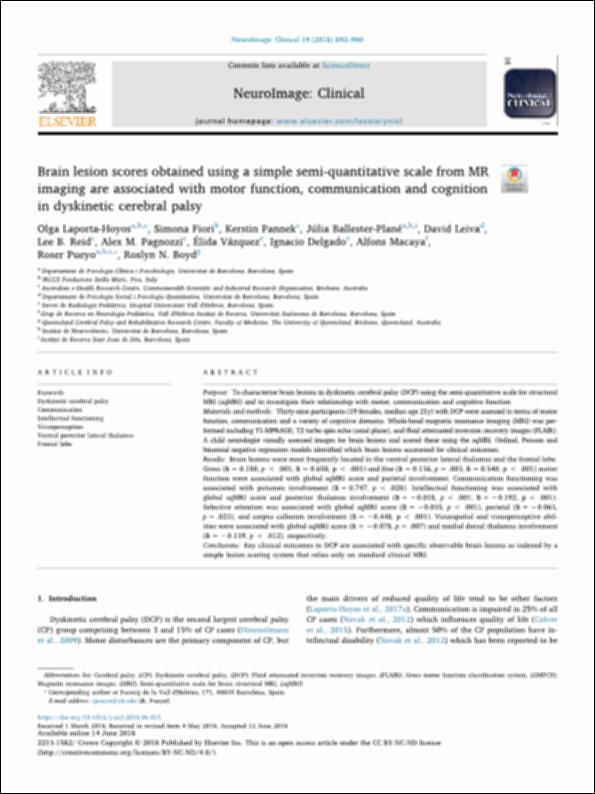Please use this identifier to cite or link to this item:
http://hdl.handle.net/10637/15130Brain lesion scores obtained using a simple semi-quantitative scale from MR imaging are associated with motor function, communication and cognition in dyskinetic cerebral palsy
| Title: | Brain lesion scores obtained using a simple semi-quantitative scale from MR imaging are associated with motor function, communication and cognition in dyskinetic cerebral palsy |
| Authors : | Laporta-Hoyos, Olga Fiori, Simona Pannek, Kerstin Ballester-Plané, Júlia Leiva, David Reid, Lee B. Pagnozzi, Alex M. Vázquez, Élida Delgado, Ignacio Macaya, Alfons Pueyo, Roser Boyd, Roslyn N. |
| Keywords: | Dyskinetic cerebral palsy; Communication; Intellectual functioning; Visuoperception; Ventral posterior lateral thalamus; Frontal lobe |
| Publisher: | Elsevier |
| Citation: | Laporta-Hoyos, Olga; Fiori, Simona; Pannek, Kerstin; Ballester-Plane, Julia; Leiva, David; Reid, Lee B.; Pagnozzi, Alex M.; Vazquez, Elida; Delgado, Ignacio; Macaya, Alfons; Pueyo, Roser; Boyd, Roslyn N. (2018) Brain lesion scores obtained using a simple semi-quantitative scale from MR imaging are associated with motor function, communication and cognition in dyskinetic cerebral palsy. NEUROIMAGE-CLINICAL. 19, pp. 892 - 900. https://doi.org/10.1016/j.nicl.2018.06.015 |
| Abstract: | Purpose: To characterise brain lesions in dyskinetic cerebral palsy (DCP) using the semi-quantitative scale for structural MRI (sqMRI) and to investigate their relationship with motor, communication and cognitive function. Materials and methods: Thirty-nine participants (19 females, median age 21y) with DCP were assessed in terms of motor function, communication and a variety of cognitive domains. Whole-head magnetic resonance imaging (MRI) was per formed including T1-MPRAGE, T2 turbo spin echo (axial plane), and fluid attenuated inversion recovery images (FLAIR). A child neurologist visually assessed images for brain lesions and scored these using the sqMRI. Ordinal, Poisson and binomial negative regression models identified which brain lesions accounted for clinical outcomes. Results: Brain lesions were most frequently located in the ventral posterior lateral thalamus and the frontal lobe. Gross (B = 0.180, p < .001; B = 0.658, p < .001) and fine (B = 0.136, p = .003; B = 0.540, p < .001) motor function were associated with global sqMRI score and parietal involvement. Communication functioning was associated with putamen involvement (B = 0.747, p < .028). Intellectual functioning was associated with global sqMRI score and posterior thalamus involvement (B = −0.018, p < .001; B = −0.192, p < .001). Selective attention was associated with global sqMRI score (B = −0.035, p < .001), parietal (B = −0.063, p = .023), and corpus callosum involvement (B = −0.448, p < .001). Visuospatial and visuoperceptive abil ities were associated with global sqMRI score (B = −0.078, p = .007) and medial dorsal thalamus involvement (B = −0.139, p < .012), respectively. Conclusions: Key clinical outcomes in DCP are associated with specific observable brain lesions as indexed by a simple lesion scoring system that relies only on standard clinical MRI. |
| Description: | Este artículo está en acceso abierto, siguiendo la política de acceso de la editorial Elsevier |
| URI: | http://hdl.handle.net/10637/15130 |
| Rights : | http://creativecommons.org/licenses/by-nc-nd/4.0/deed.es OpenAccess |
| ISSN: | 2213-1582 |
| Issue Date: | 14-Jun-2018 |
| Center : | Universitat Abat Oliba CEU |
| Appears in Collections: | Documents de recerca |
Items in DSpace are protected by copyright, with all rights reserved, unless otherwise indicated.


